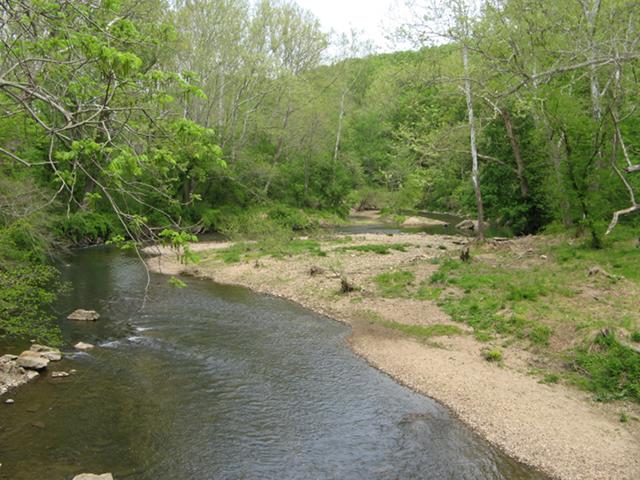Rocky Sandbar in White Clay Creek State Park in album White Clay
In Albums: nature White Clay

May 5th, 2006, by Alex Zorach
This photo shows a rocky sandbar along White Clay Creek in White Clay Creek State Park.
This photos clearly illustrates an important geological phenomenon: the deposition of material along the inside of a curve of a stream, and erosion of material along the outside of the curve. This happens because the water moves fastest on the outside of a curve, and slowest on the inside of a curve, and because the direction of the water directs the flow at the soil on the outside of the curve, but away from the soil on the inside of the curve. Note that on the left side of the stream in this picture, the trees are overhanging the creek. This is because the water is undercutting and eroding this area. On the right, the soil is mostly bare and there seems to be a great deal of soil deposition. This is because gravel and sand is being continually deposited in this area. Note also that the sandbar consists mostly of small rocks and coarse gravel. This is because the larger particles that are moved by the stream are the first to be deposited as the flow speed slows. There are few larger rocks as the stream is not fast enough to move larger rocks. Wikipedia has a good page on stream meandering which explains this process.
The gravely soil produces a unique substrate for the plants in this area. This region, with its fertile soils and temperate climate, naturally develops soil very rich in organic material, a dense, muddy sort of soil. However, this sandbar has coarse mineral soil with fewer nutrients. The plant growth in it is thus highly stunted, in contrast to the lush growth along the other side of the stream. This sandbar also floods frequently as the stream changes levels in wetter or drier periods. These factors produce a unique ecological niche.
Around the side of this photo, some of the common floodplain species are evident, such as black walnut (the foliage leafing out on the left) and American sycamore (the trees with whitish trunks).